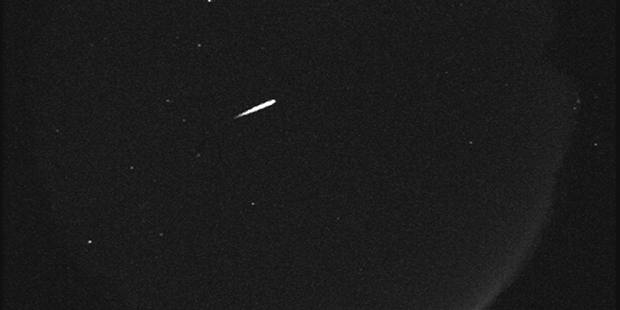Good heavens! Annual Orionid meteor shower to peak later this week
Oct 18, 2016, 2:04 PM | Updated: Oct 19, 2016, 11:11 am

An Orionid meteor recorded by the NASA All Sky Fireball Network station on top of Mt. Lemmon, Arizona on Oct. 13, 2015 at 4:31 a.m. EDT. (NASA Photo)
(NASA Photo)
Meteor season is now in full swing!
With the onset of autumn and cooler weather, get ready for the first of a series of great meteor showers: The annual Orionid meteor shower will reach its peak later this week and into early next week.
The Orionid meteor shower will reach its primary peak on Thursday night of Oct. 20 into Friday morning. This will best seen by looking to the east, just after midnight until dawn
Technically, the Orionids are visible from Oct. 2 to Nov. 7, but only a few meteors might be seen outside the peak.
This is a very famous meteor shower.
Meteor showers are simply debris from comets and the Orionids are thought to come from debris from Comet 1P/ Halley. Yes, that’s the same thing as Halley’s comet, the most famous of all periodic comets. It is called called Mankind’s Comet as it returns once in a lifetime.
The Eta Aquarid meteor shower, which typically arrives in early May, is also thought to originate from debris from Halley’s Comet.
A bright moon will hamper a bit of this year’s show, but you should be able to see about 10 meteors per hour as long as the sky is clear and you’re looking to the east.
The radiant, or point of origin of the Orionids, lies just a few degrees to the left of the bright orange super giant star known as Betelgeuse, some 600 light years from your eye!
Orion is one great constellation, so if you find a lull in the meteor shower, scan this magnificent corner of the sky and know that the light you’re seeing from Betelgeuse left this star in 1373 and is just getting here NOW!
Betelgeuse is a star that one day will collapse and create a bright supernova in our sky, but no one knows for sure when that will happen.
Scanning just below the belt stars of Orion, you will get to see the hazy group of stars and gas, known as the Orion nebula.
Good luck with the Orionids!
Get your personal October star chart here.
See you on the radio!








